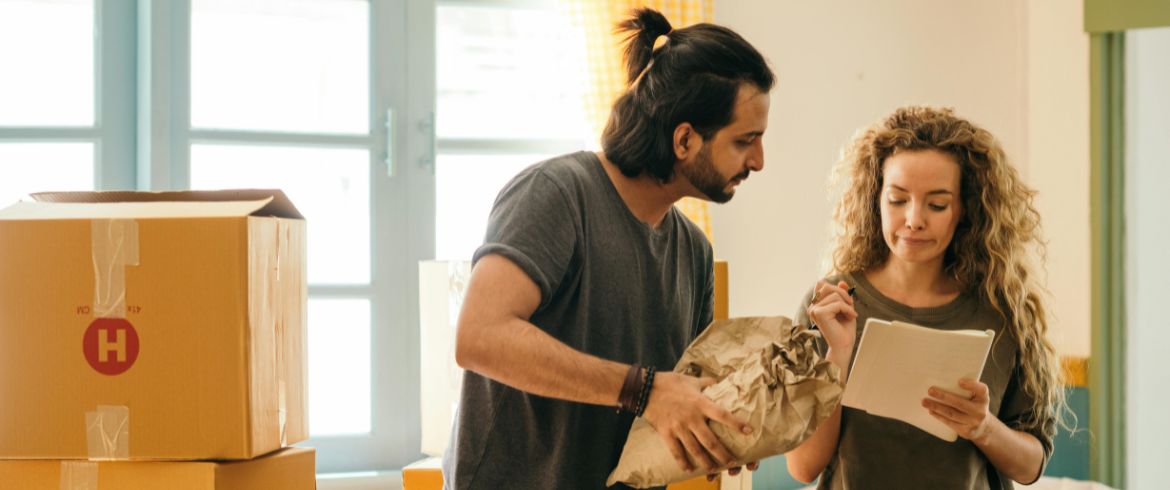Ever started packing for a move and realized just how much stuff you’ve somehow accumulated in one house? It’s like your belongings multiply behind your back. The boxes pile up, the tape runs out, and suddenly you’re coordinating a small freight operation. In the middle of all this, the last thing on most people’s minds is carbon emissions. But moving day isn’t just exhausting—it’s surprisingly wasteful. In this blog, we will share how to reduce your environmental impact when it’s time to change addresses.
Reframe Moving as an Emissions Event

A move might not seem like a big deal in the climate picture. After all, how much harm could a couple of van trips and some cardboard boxes really do? But look closer and the picture expands. The average local move can involve multiple fuel-heavy truck trips, throwaway materials, piles of landfill-bound clutter, and energy-draining last-minute purchases. Multiply that by the thousands of moves happening across the country daily, and suddenly it’s not so minor.
Even beyond the direct pollution, moving often leads to habits that spike your carbon footprint. New homes often mean a flurry of unnecessary shopping. Tossed furniture gets replaced with fast-manufactured pieces. The perfectly usable dishes you “forgot” to pack get replaced with a same-day delivery set. It all adds up.
The good news is that small, strategic choices make a measurable difference. You don’t need a sustainability certification to shrink your moving day impact—you just need a plan that focuses on waste reduction, fuel efficiency, and reuse over replacement.
Seeking Help from Professionals
Not all moving companies are the same. Some operate outdated, poorly maintained trucks that guzzle gas and leak fluids. Others are starting to adapt, offering electric or hybrid vehicle fleets, reusable packing containers, and optimized routing to cut emissions. If sustainability matters, it pays to ask questions early.
A professional team of movers who understand efficient packing, route planning, and fuel management can make a bigger impact than people realize. Less wasted space in the truck means fewer trips. Proper loading avoids item damage, reducing the need for replacements. And experience means faster work, which saves time, fuel, and energy.
Ask if the company offers reusable crates, wardrobe boxes, or packing blankets instead of single-use plastics. In cities with eco-forward policies, some companies now even offset their fuel emissions or allow customers to contribute to local environmental programs as part of the move. You don’t need to hire a “green mover” per se—but a company that prioritizes smart operations over convenience shortcuts can shrink your move’s footprint by a wide margin.
Start with Smarter Sorting
It’s tempting to throw everything in a box and sort it out later. But that’s how you end up hauling items you’ll never use and paying for extra truck space in the process. The better option is a pre-move audit. Go room by room and sort items into three categories: essentials, pass-alongs, and total exits.
Essentials are obvious. Pass-alongs include anything usable you don’t want to take with you—furniture, decor, tools, clothes—that can be donated, gifted, or sold. Exit items are damaged, expired, or genuinely unusable. For these, look for eco-friendly disposal options. Many local governments and private organizations run electronics recycling, furniture reuse, and hazardous waste drop-offs. Old paint, batteries, and lightbulbs shouldn’t go in the trash.
Giving yourself two to three weeks for this sorting step helps reduce the time crunch and avoids last-minute dump runs. It also forces you to confront your own consumption in real-time—a surprisingly powerful step toward more sustainable habits.

Rethink Packing Materials
Cardboard boxes aren’t the worst offenders, but they still require raw materials and often get trashed after one use. Try to source used boxes from local retailers, community groups, or buy-nothing groups. Liquor stores and bookstores tend to have sturdy boxes with dividers, perfect for breakables.
Instead of plastic bubble wrap, use towels, sheets, and clothing to pad fragile items. Newspaper, paper bags, and even old t-shirts can stand in for packing paper. It’s not about aesthetics—it’s about function.
Plastic stretch wrap, packing peanuts, and foam inserts are harder to replace, but not impossible. Compostable alternatives exist, and some moving companies rent reusable packing materials. The key is to avoid the “panic pack,” when you buy whatever’s available the night before the truck shows up. Planning ahead lets you gather materials with lower impact and skip the last-minute waste.

Set Up Your New Place with Sustainability in Mind
Once you land in your new space, the temptation to furnish fast kicks in. But rushing to fill every corner with new furniture usually leads to impulse buys that don’t last. Give yourself breathing room. Live in the space for a few weeks. Figure out how you use it—where you sit, cook, relax, work—before investing in permanent pieces.
Consider secondhand stores, consignment shops, and online marketplaces for furniture and decor. Not only does this reduce demand for newly manufactured goods, but it also lowers transport emissions since items are sourced locally. Bonus: vintage and repurposed items often bring more character than anything from a catalog.
For any purchases you do make, prioritize durability and material quality over trendiness. A solid piece that lasts a decade is always more sustainable than something stylish that breaks after a year.
Energy efficiency also matters early. Switch to LED bulbs, unplug phantom power drains, and install smart thermostats and outlet timers. These aren’t dramatic moves, but over time they cut emissions in a quiet, consistent way.

A Cultural Shift Toward Mindful Moving
The sustainability conversation has moved into nearly every area of life—travel, food, shopping, and construction. Moving, for a long time, escaped that scrutiny. It was treated as too stressful, too chaotic, too short-term to fix. But the more we rethink systems as a whole, the more clear it becomes that even temporary events like a move leave a lasting impact.
Now, a growing number of people are treating relocation as a chance to reset—not just their zip code, but their habits. It’s a moment of inventory, reflection, and new intention. Done well, moving can actually shrink your long-term footprint. You let go of what you don’t need. You set up smarter systems. You learn how to live lighter in a new space.
Moving day will always be messy. There’s no version where you end it completely relaxed and waste-free. But with a little planning and a few shifts in habit, it doesn’t have to come at the planet’s expense. And for anyone striving to live—and travel—in a way that aligns with sustainable values, transforming the moving process is a meaningful step forward.
Cover image: photo by Photo by Ketut Subiyanto via Pexels




